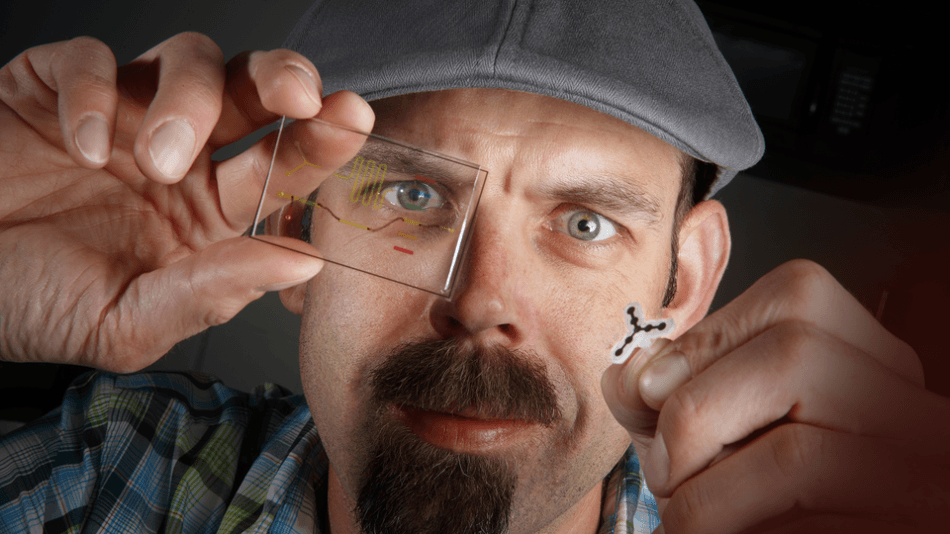Jan 11 2018
Chemists at the University of Nebraska-Lincoln bonded plastic and rubber together under pressure, which helped in simplifying the production of tiny fluid-carrying channels that not only drive movement in soft robotics, but also allow chemical analyses on microscopic scales.
 Stephen Morin and his colleagues have detailed a method for more strongly bonding plastics with silicones, offering new possibilities for fabricating fluid-carrying channels (left) that are commonly used to direct the motion of soft robotic components (right).(Photo credit: Craig Chandler | University Communication)
Stephen Morin and his colleagues have detailed a method for more strongly bonding plastics with silicones, offering new possibilities for fabricating fluid-carrying channels (left) that are commonly used to direct the motion of soft robotic components (right).(Photo credit: Craig Chandler | University Communication)
The novel method produces a stronger chemical bond between silicone and an unparalleled array of plastics, and can significantly reduce the complexity, time and cost required to develop and customize the microfluidic devices.
“We’re really excited, because we’re providing a (technique) to successfully integrate different materials in a way that is streamlined and supports numerous practical applications,” said Stephen Morin, assistant professor of chemistry. “We think that can really offer new opportunities to the community.”
While showing those opportunities, the group utilized a traditional laser printer to map small fluid-carrying channels onto a transparent Mylar sheet. They also used a basic software program to design microfluidic networks. The researchers exposed the plastic sheet to ultraviolet light and immersed it in a solution. They subsequently applied heat after laying the sheet on top of a silicone film.
The silicone and plastic bonded strongly - except where the pathways had been labeled by the printer’s ink. When air or liquid was pumped into those unbound sites, the fluids travelled through them at rates governed by the pressure being applied - pressures that were many times higher than what earlier bonding methods have withstood.
Soft robots and microscopic labs
Microfluidic networks are capable of accommodating the flow and mixture of various liquids, and they basically behave as a tiny laboratory for analytical chemistry techniques that otherwise need traditional equipment such as beakers.
In addition, airflow through microfluidic channels can direct the motion of grippers, soft-robotic arms and other components that show great potential for food processing, space exploration and remote surgery.
The analogy I use is: Would you rather have some sort of a soft gripper performing surgery on you, or would you rather have the Terminator do that. When the Terminator does it, if something goes wrong in the control-feedback loop, you have a big problem. But when you have the soft-robotic gripper doing that, if there’s a problem, it just deflates like a balloon that’s failed.
Stephen Morin, Assistant Professor of Chemistry
Usually, manufacturers produce microfluidic patterns by simply projecting the light through custom-made masks onto a chemical-treated surface, then simulating that microfluidic pattern into rubber, and eventually molding the channels prior to overlaying them with glass or plastic.
However, many researchers need to send their designs to exclusive production facilities and usually have to wait a week or more for a mask to arrive. Even a slight modification of the design can entail another weeklong wait.
On the other hand, the Nebraska team required only an hour to create a plastic-silicone segment containing microfluidic networks. The technique is different from a more conventional method for bonding silicone to plastic, and allowed the team to integrate more arrays of commodity plastics, which are economical and easily accessible varieties that earlier resisted bonding with silicone.
“We became interested in why there was a limitation in what plastics you could access, and what was going on chemically that was leading to that limitation,” Morin said. “We were surprised to find that no one had really treated that problem thoroughly. We kind of took a step back and said, ‘How can we encourage the surface chemistry to behave in a way that gives us very reliable, robust bonds?’
“People who had done anything like this before had relied on low pressures and open-channel designs, so they really weren’t advancing the fabrication process of what you see in traditional microfluidics. Here, the chemistry has been worked out in a way that … we can access these applications directly — print microfluidic devices, print soft-robotic devices.”
Creases and Sharpies
Morin and his coworkers showed that their bonding technique also provides other benefits. They demonstrated that the movement of resulting soft-robotic arms and grippers can be adjusted by creasing a Mylar sheet before melding it with silicone. For example, folding the Mylar sheet a number of times at a 90-degree angle made an arm to curl more tightly. Creasing the sheet at a 45-degree angle made the arm to bend left or right, based on which direction the team folded it. According to Morin, that level of on-the-fly versatility far surpasses what is provided by current methods.
Since ink can prevent plastic and silicone from bonding, the researchers also altered an already-printed sheet - introducing microfluidic channels to an existing design - merely using a marker to draw on it. That capability, together with the relative ease of production, could make the method appealing to science-oriented outreach groups and educators, Morin said.
“We looked at it as an interesting opportunity to even further streamline the process, where you have some sort of a template that you could perhaps mail to different educational groups or workshops,” he said. “And since you really only need an oven and a (UV) light source, you could potentially enable these groups to explore this kind of a technology, where they’re literally customizing it by using a Sharpie.”
The researchers have described their work in the journal, Advanced Materials. Morin authored the study with postdoctoral researcher Karla Perez-Toralla; doctoral candidate Jay Taylor; and Ruby Aispuro, an undergraduate student at California State University, San Bernardino.
The National Science Foundation supported the researchers in their work.